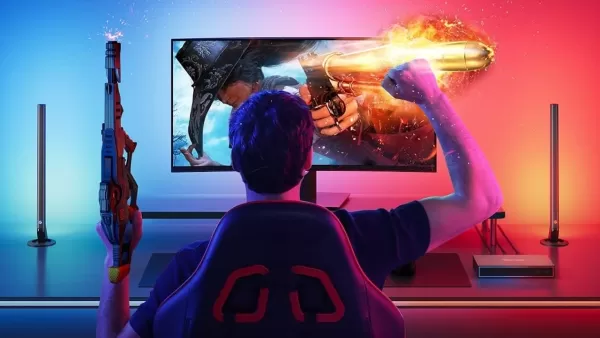Next Xbox Might Be a Gaming PC
Microsoft has unexpectedly announced a partnership with AMD for its next generation of Xbox "devices." While this collaboration comes as no surprise, it sparks important discussions about the future of gaming in this evolving landscape.
Though the silicon manufacturer for the next Xbox is now confirmed, the more significant revelation is that the Xbox team plans to "work closely with the Windows team to make Windows the number one gaming platform." Following last week's ROG Xbox Ally X announcement, this strongly suggests the next Xbox may closely resemble a gaming PC.
A Closer Windows Integration
Xbox consoles have been progressively resembling gaming PCs across recent generations, particularly in their operating systems. The similarities between the Xbox Series X interface and Microsoft's desktop OS are unmistakable, especially for users familiar with Windows 8 and Windows 10.
In Microsoft's AMD partnership video, Xbox president Sarah Bond emphasized the company's vision of enabling players to "play the games you want, with the people you want, and wherever you want." This philosophy isn't new for Microsoft, which has prioritized accessibility through initiatives like Play Anywhere.
As someone who plays across both Xbox and PC platforms, I appreciate the seamless progress synchronization. While speculative, Microsoft appears poised to expand this ecosystem further. Bond's mention of an Xbox experience "not locked to a single store" potentially hints at integration with platforms like Steam and Epic Games Store - a logical progression given Microsoft's recent ROG Ally partnership.
The ROG Ally X as a Prototype
Microsoft's collaboration with Asus on the ROG Ally X stands apart from other Windows handhelds through its customized Windows implementation. Though specific modifications remain undisclosed, we know it selectively loads desktop components only when necessary.
More significantly, the device boots directly into an enhanced Xbox App interface rather than the traditional desktop - mirroring SteamOS's approach on the Steam Deck. This streamlined interface enhances both usability and gaming performance by optimizing system resource allocation.
This development suggests Microsoft is preparing essential optimizations that could equally benefit a Windows-based next-generation Xbox console. It would be surprising if these innovations were limited solely to the Ally X.

Why the Next Xbox Should Embrace PC Architecture
The current PC gaming market presents both opportunities and challenges. While hardware capabilities have never been better, affordability remains a significant barrier. Even impressive handheld devices like the Lenovo Legion Go command premium prices compared to traditional consoles.
Microsoft bears partial responsibility for this pricing structure - Windows licensing adds to the cost of gaming PCs and handhelds. This explains why similarly-specced devices like the ROG Ally Z1 exceed Steam Deck pricing despite comparable hardware.
Consoles traditionally offset hardware costs through software licensing, allowing more accessible price points at launch. Microsoft now has the chance to apply this model to what could effectively become a purpose-built gaming PC.
With PC gaming's popularity surging, this hybrid approach could introduce new audiences to expansive gaming ecosystems. Given the persistent high costs of graphics cards, a PC-compatible next-gen Xbox might provide the revitalization the PC gaming sector currently needs.
-
If you're a fan of puzzle games, you've almost certainly explored titles from Rusty Lake. To commemorate their 10th anniversary, the studio has prepared a series of exciting surprises, including a brand new game release, a special short film, and sigAuthor : Zoe Dec 21,2025
-
Star Wars Outlaws fans can return to a new tale of intergalactic smuggling on May 15, when the game’s second story pack launches across all current platforms. Season pass holders receive it free; otherwise, prepare to spend $14.99 in credits to joinAuthor : Grace Dec 21,2025
-
 Selobus FantasyDownload
Selobus FantasyDownload -
 Braindom: Brain Games TestDownload
Braindom: Brain Games TestDownload -
 Idle World - Build The PlanetDownload
Idle World - Build The PlanetDownload -
 Claras Love HotelDownload
Claras Love HotelDownload -
 Neon SplashDownload
Neon SplashDownload -
 Guess the Word. Word GamesDownload
Guess the Word. Word GamesDownload -
 The Ball Game - Quiz GameDownload
The Ball Game - Quiz GameDownload -
 Mars SurvivorDownload
Mars SurvivorDownload -
 Let's do it! Gal-chan ~Fix your money and grades with sex~Download
Let's do it! Gal-chan ~Fix your money and grades with sex~Download -
 Soul Quest: Epic War RPGDownload
Soul Quest: Epic War RPGDownload
- Black Ops 6 Zombies: How To Configure The Summoning Circle Rings on Citadelle Des Morts
- Harvest Moon: Lost Valley DLC and Preorder Details Revealed
- Roblox: Latest DOORS Codes Released!
- Silent Hill 2 Remake Coming to Xbox and Switch in 2025
- Roblox: Blox Fruits Codes (January 2025)
- Roblox: Freeze for UGC Codes (January 2025)







![Taffy Tales [v1.07.3a]](https://imgs.ehr99.com/uploads/32/1719554710667e529623764.jpg)




